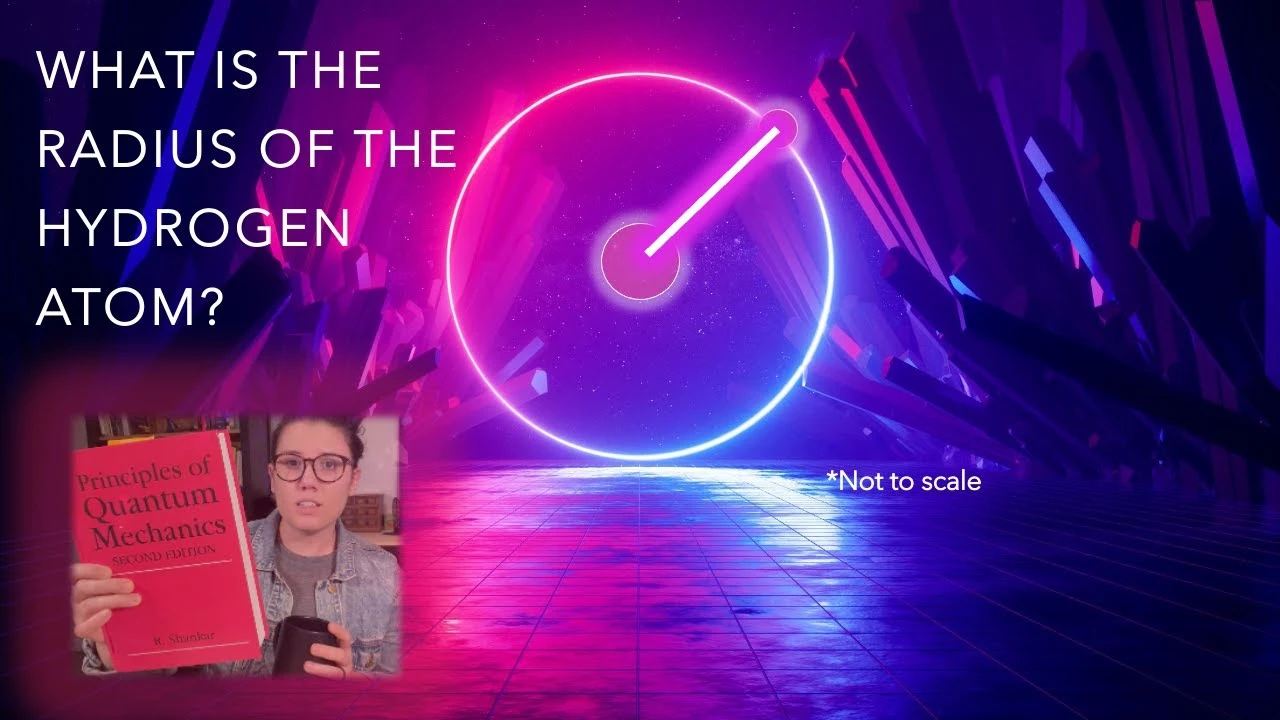1h video, so I won’t watch it right now. (I do recommend people to do it though - from quick glances she’s rather didactic.)
That said, the radius depends on what you’re looking for, and odds are that her video explains this:
If you’re dealing with an isolated hydrogen atom, and you want to be bloody 100% sure that you got it full (electron and nucleus), then the radius is infinite. Because that’s how wave functions work, even if the nucleus is here there’s a non-zero chance that the electron is in the Moon.
If “infinite” is too much you can’t be picky. You can use a₀ instead (Bohr radius), that is the most probable distance between the electron and the nucleus. Then the radius is 53pm, it’s the distance that she mentions in the video description.
There are other ways to do this if you’re accepting that your atom is not isolated. You could use the covalent radius instead, measuring the distance between two hydrogen nuclei in a H₂ and dividing it by two. You’ll get 25±5pm; smaller than the above because they share the electrons, so it’s like the atoms overlap.
Then there’s the Van der Waals radius; it’s a bit of a silly simplification, where you pretend that the atoms are dense, tightly packed, and non-overlapping spheres at 0°K. Then from the resulting volume you get the radius of each atom, for hydrogen it’s 109pm. (This “let’s pretend” stuff might sound weird, and it is, but it’s still useful to know the volume of the gas more precisely than the equation pV = nRT would allow you to.)
Thanks for the TL;DW! Will definitely check it out!
It’s more of a “what I remember about this” than a “TL;DW”, as I didn’t watch the vid. It seems to me that she’s focusing on the maths behind the isolated H atom, that I simply glossed over. Still, glad to be of help!
I fucking love Dr Angela Collier
It’s really good news to see her here.
EDIT: Oh boy I did so many typos on this one…
Easy, just take the diameter and divide by twoish. It aint rocket surgery folks.
I watched it just yesterday and even though the maths gets over my head sometimes (especially here when she demonstrates the analytical solution with the Schrödinger equation thing), she’s really good at explaining these concepts.
The only thing I didn’t quite understand, and maybe I just didn’t pay attention in the video: If electrons aren’t particles but waves, what does it mean for an atom/molecule to have x electrons? Are “two electrons” just a more intense wave than “one electron”? And this electron wave… wouldn’t it constantly change its position due to it being a wave (stuff needs to move to create waves, right?) or is that what physicists are talking about when they say the probability of the electron to be at location y?
An electron is both a particle and a wave. This can be confusing, because an electron can also create waves (called photons, which are both waves and particles too) when it changes energies. Basically if you measure an electron’s position, it will behave like a particle, but when unmeasured, it will exist in a region of space described by a probability equation, like a wave. If you measure the location repeatedly over a time period and super-impose those measurements, it will look like a cloud of electrons taking the shape of the electron’s probable location in space. But when it is not being measured, it doesn’t constantly ‘move’ - it exists everywhere inside that shape at the same time, the same way a sound exists everywhere in a room at once.
Those regions of probability are called orbitals, but they don’t look like planetary orbits – that’s just the name they got from Bohr’s flawed model. Here’s a sample of some of the more elegant shapes an orbital can take. In these pictures, the hazy cloud you might see in the super-imposed example is replaced with a solid shell so the shape is more obvious.

The pictured shapes are all scaled to look roughly the same size, but with more electrons, you get larger and stranger shaped electron clouds, which again, represent the likelyhood of finding an electron there if you measured it.






